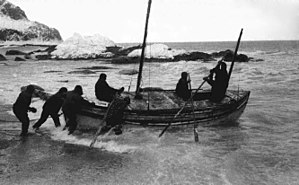Scotia Sea
57°30′S 40°00′W / 57.500°S 40.000°W


The Scotia Sea is partly in the Southern Ocean and mostly in the South Atlantic Ocean.
Location and description
changeNormally stormy and cold, the Scotia Sea is the area of water between Tierra del Fuego, South Georgia, South Sandwich Islands, South Orkney Islands and the Antarctic Peninsula. It is bordered on the west by Drake Passage. These island groups all sit on top of the Scotia Ridge. The Scotia Sea covers an area of about 900,000 km². About half of the sea stands above the continental shelf.
The islands are rocky and partly covered in ice and snow year round.
Flora and fauna
changeThe islands do have vegetation. They have been called Scotia Sea Islands tundra ecoregion. These include South Georgia, the volcanic South Sandwich Islands and the South Orkneys in the Scotia Sea as well as the remote South Shetland Islands near the Antarctic Peninsula and the small isolated volcano Bouvet Island. All these islands are in the cold seas below the Antarctic convergence. These areas have tundra vegetation of mosses, lichen and algae. Seabirds, penguins and seals feed in the surrounding waters.
Seabirds include four species of albatross: Black-browed Albatross (Diomedea melanophris), Grey-headed Albatross (Thalassarche chrysostoma), Light-mantled Albatross (Phoebetria palpebrata), and Wandering Albatross (Diomedea exulans). There are only five species of bird that stay on land. These include two endemic species: a race of the Yellow-billed Pintail duck(Anas georgica) and South Georgia Pipit (Anthus antarcticus).
Penguin species found here include large numbers of King Penguins, as well as Chinstrap Penguin, Macaroni Penguin, Gentoo penguin, Adelie Penguin, and Rockhopper Penguin (Eudyptes chrysocome).
Seals include the Antarctic Fur Seal (Arctocephalus gazella) and Sub-Antarctic Fur Seal (Arctocephalus tropicalis) in large numbers, Leopard Seal (Hydrurga leptonyx), Weddell Seal (Leptonychotes weddellii), the huge Southern Elephant Seal (Mirounga leonina), and Crabeater Seal (Lobodon carcinophagus).[1]
South Georgia, the South Sandwich Islands and Bouvet Island are protected as nature reserves. Bird Island, South Georgia is a site of special scientific interest.
References
changeOther websites
changeMedia related to Scotia Sea at Wikimedia Commons